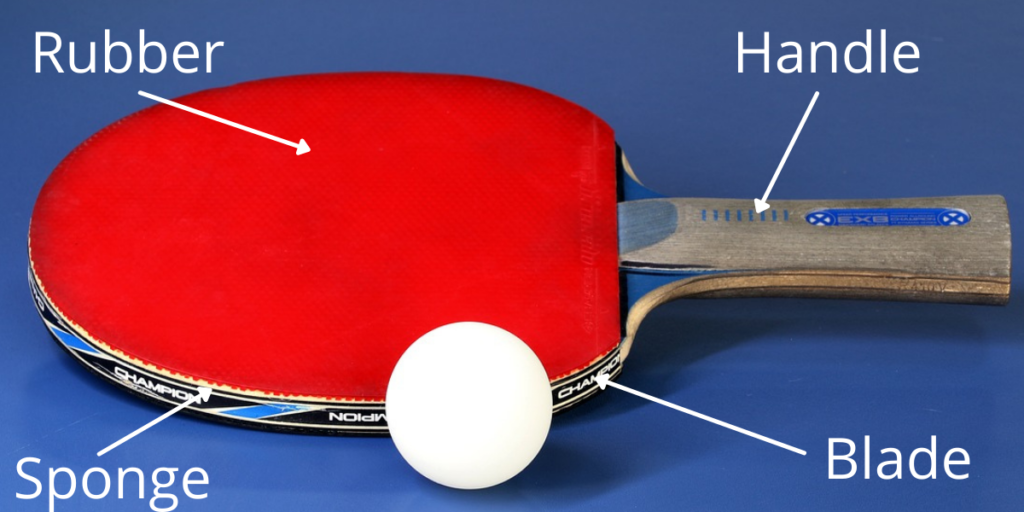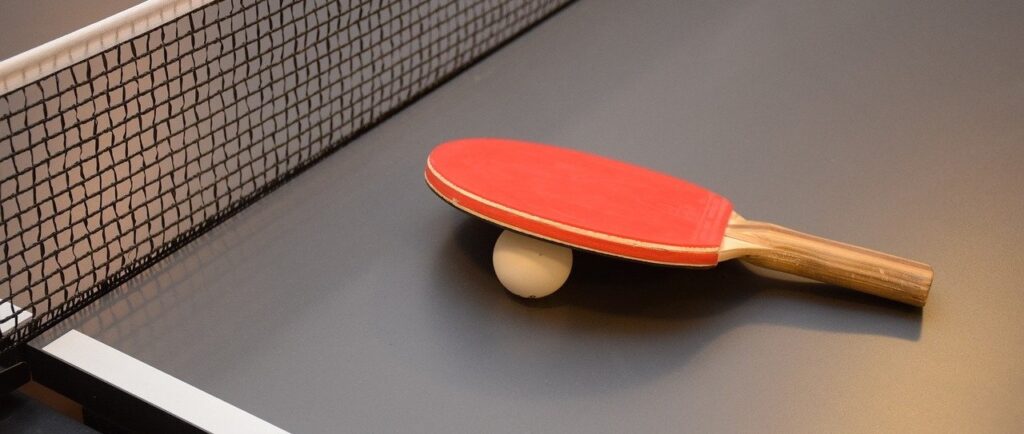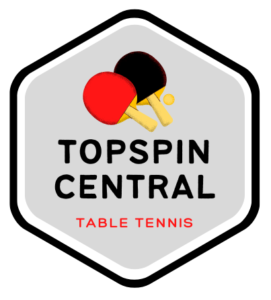Knowing how much you should be paying for a ping pong paddle is the first step when searching for the best one to buy.
In this article, I’ll take you through the average cost of a table tennis racket and the different factors that affect the overall price so you know exactly how much you need to spend to get the perfect one for you.
The Quick Answer
Table tennis paddles typically cost between $10 and $100, however for a good quality paddle you should expect to pay at least $30. High-level players and professionals will usually have a custom paddle which means the components are purchased separately and this usually cost upwards of $200.

Types of Ping Pong Paddle
I wanted to fill this article with plenty of examples so you can see what kinds of table tennis paddles you can get at different price points, so I’ve split it into the following categories.
- Budget rackets
- Entry-level rackets
- Mid-level rackets
- High-level rackets
- Custom rackets (professional)
Budget Rackets
Budget ping pong paddles usually cost between $5-$10. These are designed solely for very casual players. For players who want to get a decent level of performance from their paddle, these budget rackets are certainly not recommended as they are made from inferior materials.
Many budget table tennis paddles do not have a sponge layer and this is what separates them from the more expensive paddles. Cheaper paddles that actually have a sponge layer usually have a very thin one that doesn’t function very well. Some also have a plastic blade instead of a wooden blade, which offers much less performance.
In the vast majority of cases, these kinds of paddles are not recommended because for slightly more money, you’ll get a miles better paddle that you can learn to play the game with properly. Any paddle with a plastic blade or without a sponge layer will severely limit your progress.

Here is a table showing some examples of budget paddles and their average prices.
| Paddle | Average Price | Material |
| Franklin Sports Ping Pong Paddle | $4 | Wood and rubber |
| Cannon Sports Table Tennis Paddle | $5 | Plastic |
| S&S Worldwide Table Tennis Paddle | $6.80 | Wood and rubber |
| Dunlop Nitro Power Table Tennis Racquet | $7.50 | Wood, rubber and sponge |
| Stiga Check Table Tennis Paddle | $10 | Wood, rubber and sponge |
Entry-Level Rackets
Paddles in this category typically cost between $18-$35 and will have a sponge layer and wooden blade. These are all suitable for players who are first getting into table tennis and want a decent paddle which will not limit their development but do not want to spend as much at this stage.
Typical features: 5-ply wooden blade with a soft/ moderate hardness sponge and rubber layer.
Here is a table showing some examples of entry-level table tennis paddles and their average prices.
| Paddle | Average Price | Blade Material | Blade Layers | Sponge Thickness |
| Butterfly RDJ S4 | $18 | Wood | 5-ply | 1.9 mm |
| Gewo Rave Speed | $18 | Wood | 5-ply | 2.0 mm |
| JOOLA Omega Control | $20 | Wood | 5-ply | 1.8 mm |
| JOOLA Champ | $35 | Wood | 5-ply | 1.9 mm |
| Killerspin JET 200 | $35 | Wood | 5-ply | 2.1 mm |
Mid-Level Rackets
Mid-level table tennis rackets typically cost between $40-$80 and are designed for players who have a decent level of experience (usually at least a year’s worth) and want to take their performance to the next level. Paddles in this price range offer very good value for money.
Typical features: 5-ply wooden blade and a moderate hardness rubber and sponge layer.
Here is a table showing some examples of mid-level table tennis paddles and their average prices.
| Paddle | Average Price | Blade Material | Blade Layers | Sponge Thickness |
| Butterfly 303 FL | $40 | Wood | 5-ply | 2.1 mm |
| JOOLA Attack | $50 | Wood | 5-ply | 1.8 mm |
| Stiga Flash | $60 | Wood | 5-ply | 2.0 mm |
| Killerspin Impact D5 | $60 | Wood | 5-ply | 2.0 mm |
| Stiga Force | $80 | Wood | 7-ply | 2.0 mm |
High-Level Rackets
Table tennis rackets aimed at serious players competing in their first tournaments will typically cost around $100-$200.
These paddles will have higher quality blades and rubber/ sponge layers to offer maximum performance. They may have either 5 or 7 layers, which can be compromised from either wood or carbon. The sponge hardness and tackiness of the rubber will vary depending on the player’s personal preference.
These are designed for players who are getting very serious about table tennis, but professionals and very high level players will typically choose rackets in the next category. If you already have a mid-level racket and want to step up the quality, then also consider a custom racket (next category) instead of one in the table below.
Here is a table showing some examples of high-level table tennis paddles and their average prices.
| Paddle | Average Price | Blade Material | Blade Layers | Sponge Thickness |
| JOOLA Carbon Pro | $95 | Wood and carbon | 7-ply | 1.9 mm |
| JOOLA Tournament Combo | $95 | Wood | 5-ply | 2.0 mm |
| Butterfly Timo Boll Allround Proline | $135 | Wood | 5-ply | 2.1 mm |
| Killerspin Kido 5A Premium | $160 | Wood | 5-ply | 2.0 mm |
| Killerspin Kido 7P Premium | $200 | Wood | 7-ply | 2.0 mm |

Custom Rackets
Professional and competitive table tennis players will almost always use a custom table tennis racket. This is when the blade and rubber/ sponge layers are purchased separately and glued together to get certain specific characteristics. The overall cost of a custom racket usually ranges from $100 to $300, but can cost over $500.
For a custom racket you’ll need:
- Blade
- Forehand rubber and sponge layer
- Backhand rubber and sponge layer
If you are purchasing all three components from the same store, often you’ll be able to pay a small additional fee to have the paddle constructed for you so purchasing a custom paddle is not really much extra hassle.
If you’re considering one of these kinds of rackets, then you might already know that the rubber component of the paddle is likely to wear out and need replacing 2-3 times per year, so keep this in mind when selecting your rubber.
Blade
Table tennis blades typically cost between $30 and $200, however they can cost over $300. They may be compromised of either wood or carbon fibre, typically in 5 or 7 layers (known as 5-ply or 7-ply blades). They vary in terms of their weight and hardness which impacts the speed and spin abilities of the blade.
Here is a table showing some examples of professional-level table tennis blades and their average prices.
| Blade | Average Price | Classification | Layers |
| JOOLA Challenger All | $30 | All-round | 5-ply wood |
| Yasaka Sweden Classic | $38 | Defensive | 5-ply wood |
| GEWO Power Allround | $40 | All-round | 5-ply wood |
| Butterfly Timo Boll Control | $55 | All-round | 5-ply wood |
| Yasaka Galaxya Carbon | $60 | High-speed | 5+2 ply wood and carbon fibre |
| Donic Original Carbospeed | $75 | High-speed | 3+2 ply wood and carbon fibre |
| Stiga Defensive Pro | $85 | Defensive | 5+2 ply wood and carbon fibre |
| Butterfly SK7 Classic | $90 | Offensive | 7-ply wood |
| GEWO Sensus Carbo Touch | $120 | Offensive | 5+2 ply wood and carbon fibre |
| JOOLA Air Fibre | $130 | All-round | 5+2 ply wood and carbon fibre |
| Butterfly Sardius | $135 | High-speed | 3+2 ply wood and carbon fibre |
| XIOM Ice Cream AZX | $155 | Offensive | 5+2 ply wood and carbon fibre |
| Butterfly Viscaria | $185 | High-speed | 5+2 ply wood and carbon fibre |
| JOOLA Vyzaryz Hybrid | $250 | Offensive | 5+2 ply wood and carbon fibre |
| Butterfly Revoldia CNF | $350 | Offensive | 5+2 ply wood and carbon fibre |
Rubber and Sponge
Although the rubber and sponge components of a table tennis racket have different functions, they typically come together as a single sheet which is often referred to as just the rubber. Players will normally select different sheets for the backhand and forehand to give them different characteristics to suit their playing style.
Table tennis rubbers usually cost between $18-$100, with the average being around $50. If you’re considering one of these kinds of rackets, then you might already know that the rubber component of the paddle is likely to wear out and need replacing 2-3 times per year, so keep this in mind when selecting your rubber.
Here is a table showing some examples of professional-level table tennis rubber and sponge sheets and their average prices.
| Rubber | Average Price | Classification | Hardness | Tackiness |
| Yasaka Original | $18 | All-round | Moderate-soft | Slight |
| Butterfly Flextra | $25 | Defensive | Moderate-soft | Slight |
| DHS Hurricane 3 Neo | $25 | High-speed | Moderate-hard | Very |
| Andro GTT 45 | $30 | All-round | Moderate | Slight |
| Butterfly Super Anti | $30 | Anti-spin | Moderate-soft | Non-tacky |
| Yasaka Anti-Power | $32 | Anti-spin | Soft | Non-tacky |
| XIOM Vega Pro | $35 | All-round | Moderate | Slight |
| XIOM Vega Def | $40 | Defensive | Hard | Slight |
| Andro Hexer Grip | $40 | Offensive | Moderate | Non-tacky |
| Donic BlueGrip R1 | $40 | High-spin | Moderate | Moderate |
| JOOLA Maxxx 400 | $50 | All-round | Moderate-soft | Slight |
| Donic Bluefire M3 | $50 | All-round | Moderate-soft | Slight |
| Stiga Mantra H | $50 | High-speed | Hard | Slight |
| JOOLA Rhyzer 43 | $50 | High-spin | Moderate | Non-tacky |
| DHS Gold Arc 8 | $50 | High-spin | Moderate-hard | Slightly |
| Stiga DNA Pro M | $55 | Offensive | Moderate | Slightly |
| DHS Hurricane 3 Provincial – Blue | $55 | High-spin | Moderate-hard | Very |
| Butterfly Tenergy 80 | $80 | High-speed | Moderate | Slight |
| Butterfly Tenergy 19 | $82 | High-spin | Moderate | Slight |
| Butterfly Dignics 64 | $90 | High-speed | Moderate | Slight |

What Affects the Price?
So now we’ve been through some examples of different types of paddles and their average prices, I wanted to take a more in-depth look into why some rackets cost more than others, and if the extra cost is really worth it.
The price of a ping pong paddle is based on the level of performance it provides. More affordable table tennis paddles will typically be made from lower quality materials, whilst more expensive professional-level paddles will use the most premium blades and rubbers to get maximum performance.
Materials
As mentioned above, the more expensive the paddle is, the higher the quality the materials are likely to be. This applies to the rubber and sponge layer, but it’s most noticeable when looking at the blades. Blades can be made from either wood, or carbon fibre and wood.
You’ll have seen this in the tables above, that blades are often grouped into 4 types:
- 5-ply – all wood
- 7-ply – all wood
- 3+2 ply (3 wood layers and 2 carbon fibre layers)
- 5+2 ply (5 wood layers and 2 carbon fibre layers)
Typically, blades with a carbon fibre and wood composition are stiffer and offer more power and speed despite having a more lightweight design to aid with reaction-time than all-wood blades. Carbon blades are often used by professional players as they offer the best performance and this comes with a higher price tag.
Let’s look at some examples.
| Brand | Cheapest Blade | Cheapest Carbon and Wood Blade |
| Yasaka | 2040 – $30 | Ma Lin Soft Carbon – $50 |
| JOOLA | Challenger All – $30 | Challenger Carbon – $40 |
| Donic | Waldner Offensive 2016 – $40 | Waldner Senso Carbon JO Shape – $60 |
| Stiga | Allround Classic – $40 | Offensive Classi Carbon – $90 |
| Butterfly | Xstar V – $40 | Gionis Carbon ALL+ – $60 |
Performance
To evaluate how much the performance increases as the price increases, it’s best to look at blades and rubbers separately.
When I’m talking about performance, I’m really discussing speed and spin as these are the most important tools you can use to win a game. Most brands give their blades and rubbers a rating for each of these two factors so let’s take a look at them.
Let’s start with blades. Speed is the biggest factor to consider here but control is also important. Sometimes this is a trade-off with speed, so I’ll leave this out of the comparison as this is arguably less important for the professional player.
Check out this table comparing some of JOOLA’s offensive blades. I’ve chosen these to compare as they are usually faster compared to all-round and defensive style blades, and mixing types won’t make the same point here.
| JOOLA Blade | Average Price | Speed Rating |
| Challenger OFF | $35 | 93 |
| Classic OFF | $40 | 94 |
| Classic Carbon OFF | $55 | 99 |
| Solja OFF Plus | $120 | 96 |
| Energon Super PBO-C | $270 | 110 |
The rubber component of the paddle impacts the speed and spin of the ball. I’ve chosen Butterfly as an example to demonstrate here because they are very well-known for their rubbers. Let’s look at a table comparing the ratings in the Butterfly range. This just includes the standard versions of each type of rubber (excluding hard/ soft variants etc.) to keep things clearer.
| Butterfly Rubber | Average Price | Spin Rating | Speed Rating | Combined Rating |
| Flextra | $20 | 87 | 82 | 169 |
| Sriver | $35 | 80 | 100 | 180 |
| Aibiss | $38 | 110 | 105 | 215 |
| Roundell | $55 | 102 | 128 | 230 |
| Bryce | $67 | 95 | 120 | 215 |
| Tenergy 05 | $80 | 115 | 130 | 245 |
| Diginics 05 | $95 | 120 | 135 | 255 |
Playing Style
If you’ve already been having a look at the difference between expensive and cheaper paddles, you may have noticed that the defensive and all-round style paddles are typically slightly cheaper than the offensive style paddles. The same goes for when you’re comparing the price of blades on their own.
Paddles and blades are usually split into three main categories: offensive, all-round and defensive. You can also get variants of these main categories in the form of a “plus” or “minus”. For example, an offensive plus blade will be more “offensive” than an offensive minus blade.
Typically, the higher the speed rating, the more offensive a blade may be classed as, however this also usually has a detrimental impact on the control rating.
Offensive blades are usually more expensive than defensive blades as they often offer better “performance” in terms of their speed.
That’s not to say that offensive blades/ paddles are better than all-round and defensive versions. It’s all personal preference and it’s based on your own playing style. But take it as a win if you’re more of a defensive player because it usually means you’ll save a bit of money!
How Much Should I Spend on a Table Tennis Paddle?
This depends on your skill level and budget so it’s really a personal thing. However, here are some guidelines for different types of players.
- Beginners: for a good entry-level paddle, you should expect to pay around $30. This will be suitable to get you started without over-spending for better performance that you’re unlikely to notice at this stage.
- Players with 1-2 years experience: expect to pay around $60-$80 for a paddle that’ll be a step-up from your entry-level version, but still offers good value for money.
- Serious players: if you are looking to compete then you will be best off with a custom paddle which typically costs around $200. This usually works out as around $100 for the blade and $50 for each rubber but the price may vary depending on the exact features you’re looking for.
